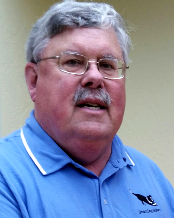
SMART DOG MININGTM
It
takes a smart dog to find hidden treasures
Earthmoving in Mining Operations
Chapter 5: HYDRAULIC EXCAVATORS
Hydraulic excavators are designed to excavate below the ground
surface on which the machine rests. These machines have good
mobility and are excellent for general-purpose work, such as
excavating trenches and pits.
Because of the hydraulic action of their stick and bucket
cylinders, they exert positive forces crowding the bucket into the
material to be excavated.
The major components of the hydraulic hoe are the boom, the
stick (arm), and the bucket.
DESCRIPTION
Fast-acting, variable-flow hydraulic systems and easy-to-operate
controls give hydraulic excavators high implement speed and breakout
force to excavate a variety of materials. The hydraulic hoe is ideal
for excavating below the ground’s surface on which the machine
rests. A large variety of booms, sticks, buckets, and attachments
give these excavators the versatility to excavate trenches, load
trucks, clean ditches, break up concrete, and install pipes.
Large excavators (Figure 5-1) can handle large volumes.
The small excavators (Figure 5-2) can work in tight
places and has good mobility


Figure 5-1. Large Excavator
Figure 5-2. Small Excavator

Figure 5-3. Hoe-Bucket Operating Dimensions

Figure 5-4. Digging Trenches With a Hoe Attachment

Figure 5-5. Two Methods of Excavating Containment/Ponds

Figure 5-6. Track-Mounted Excavator
|
Table 5-1. Bucket Fill Factors for Hoe Buckets |
|
|
Material |
Fill Factor Percent* |
|
Moist loam or sandy clay |
1.00 to 1,10 |
|
Sand and Gravel |
0.95 to 1.10 |
|
Blasted rock: |
|
|
Well blasted |
0.60 to 0.75 |
|
Average |
0.50 to 0.60 |
|
Poor |
0.40 to 0.50 |
|
Hard tough clay |
0.80 to 0.90 |
|
*Decimal of heaped-bucket capacity, for adjustment to LCY |
|
|
Table 5-2. Average Cycle Times for Excavators |
|
|
Excavator Size, |
|
|
Heaped-Bucket Capacity |
|
|
(Cubic Yards) |
Cycle Time (Minutes) |
|
Under 1.0 |
0.25 |
|
1.0 to 5.0 |
0.3 to 1.0 |
|
Over 5.0 |
1.0 to 1.5 |
|
NOTE: Includes load, maneuver with four reversals of |
|
|
direction (minimum travel), and dump. |
|
Step 2.
Roll the bucket toward the machine until it is full.
Step 3.
Raise the bucket, in a smooth operation, high enough above the
trench to clear the spoil pile or the hauling unit, and dump the
excavated material.

Figure 5-7. Bucket-Cylinder Operation
Step 2.
Roll the bucket until the bucket teeth or the cutting edge is flat
on the ground Step 3. Use the stick cylinder to move
the bucket toward the machine until it is half full Step 4.
Raise the stick and roll the bucket until it is full

Figure 5-8. Hoe Digging Technique
-
Use the bucket cylinders to help break the ground loose instead
of depending on the forward movement of the machine, as in the
loader crowding technique.
-
Do not raise the bucket higher than necessary to dump the
material.
-
Use as flat a ramp as possible when starting an excavation. Plan
the job so that most of the hauling from the excavation can be
done when driving the unit forward. A steeper ramp can be used
when driving forward than when driving in reverse.
-
Keep the working area level.
-
Plan and lay out the area of operation.
-
Spot the truck so that the hoe does not have to turn (revolve)
more than 90° (V-positioning, discussed in Chapter 10, is
often appropriate
-
Keep the working area smooth.
-
Raise the bucket while moving toward the truck.
-
Lower the bucket while moving away from the truck.
-
Shake the bucket only when necessary to loosen dirt stuck in the
bottom of the bucket.
-
Position the machine at approximately a 45° angle to the length
of the trench and its spoil pile.
-
With the bucket raised about 2 inches above the natural ground,
use it like a dozer blade to push the material into the trench.
Keep the bucket level
while pushing the material; do not crowd/curl. After the
material falls into the trench, reverse the machine and move
along the pile to repeat pushing.
-
After the last pass, dump the material remaining in the bucket
into the trench. If the material in the spoil pile along the
trench is higher than 2 feet or is wet, attack the pile in two
passes. Take off the upper half with the first pass and the
remainder with a second cleanup pass.
On utility jobs the excavator many need to lift and swing heavy
sections of pipe into a trench. Sometimes these machines are used to
hoist and unload materials from trucks. The weight an excavator can
lift depends on the distance the load is from the center of gravity
of the machine. Always refer to the current specification sheets
before attempting a lift. Position the machine as close to the load
as possible. The other critical element to consider is swing and
position. The lifting capability is 65 to 70 percent greater over
the front of the machine than over the side. These machines are
designed to handle 15,000 pounds (at a swing radius of 15 feet) over
the side.
-
Width of the excavation.
-
Depth of the cut.
-
Material type.
-
Working radius for digging and dumping.
-
Required bucket dumping height.
![]()
![]()
![]()
![]()
![]()
![]()

o
40+
years’ experience in the mining industry with strong mineral
processing experience in Precious metals, copper, industrial
minerals, coal, and phosphate
o
Operational experience in precious metals, coal, and phosphate plus
in petrochemicals.
o
Extensive experience studies and feasibility in the US and
international (United States, Canada, Mexico, Ecuador, Columbia,
Venezuela, Chile, China, India, Indonesia, and Greece).
Chapter 2: Dozers
Chapter 3: Scrapers
Chapter 4: Loaders
Chapter 5: Excavators
Chapter 6: Dump Trucks
